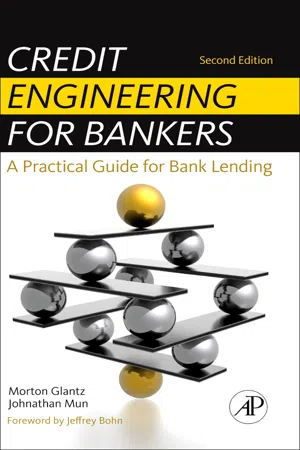Chapter 1 Introduction to Loan Decision Making: The PRISM Model
Chapter Outline
- Management 5
- Business Operations 5
- Company Information 5
- Industry Information 6
- Management Basics 6
- Bank Relationship 7
- Financial Reporting 8
- Intention (Purpose) 8
- Repayment 9
- Internal Repayment Sources: Short-Term Loans 9
- External Repayment Sources: Short-Term Loans 11
- Internal Repayment Sources: Long-Term Loans 12
- External Repayment Sources: Long-Term Loans 13
- Safeguards 13
- Collateral 14
- Guarantees 14
- Covenants 14
- Perspective 15
Unlike Mark Twain’s cat that once sat on a hot stove lid and would never again sit even on a warm one, bankers should always be careful to get from an experience just the wisdom that is in it—no more, no less. Banks need a sense of caution in a liberal credit environment, but they also need the courage and wisdom to take reasonable risks when credit is tight. Financial institutions succeed as long as the risks they assume are prudent and within defined parameters of portfolio objectives. Policies and procedures should be in place that ensure that exposures are properly identified, monitored, and controlled, and that safeguards against nonperformance or default match the risk levels to which banks commit.
By and large, bank failures are caused by lax credit standards, ineffectual portfolio risk policies, and risks taken in excess of capital constraints. In addition, blame is due to lenders who neglect technological advances in the field. While recent bank failures owe much to the collapse of the housing market, sloppy lending practices contributed to it at least in part—that is, in spite of regulators’ dire warnings of the consequences slack underwriting standards would have in the wake of sharp industry/economic meltdowns. As it turned out, liberal credit came on the heels of a robust economy, intense competition to turn deals, pursuit of the bottom line, and the misguided notion that good things—capital adequacy in particular—last forever. Credit meltdown can be something of a paradox, given that regulators have always championed sound, diversified credit portfolios and formal credit evaluation and approval processes—procedures whereby approvals are made in accordance with written guidelines and granted by appropriate levels of management. There also should be a clear audit trail confirming that the approval process was complied with, identifying line lenders and/or committee(s) influencing (lending) decisions or actually making the credit decision.1
It turned out that the banks that experienced such failures often lacked adequate credit review processes. Solid, tight credit reviews not only help detect poorly underwritten credits, but they largely prevent weak proposals from being approved since credit officers are likely to be more diligent if they know their work will be subject to review. An effective evaluation process establishes minimum requirements for the information on which the analysis is to be based. There should be policies in place regarding the information and documentation needed to approve new credits, renew existing credits, and/or change the terms and conditions of previously approved credits. The information received will be the basis for any internal evaluation or rating assigned to the credit, and its accuracy and adequacy is critical to management making appropriate judgments about the acceptability of the credit.2
The review process starts with a comprehensive appraisal of the obligor’s creditworthiness, calling for a thorough understanding of the strength and quality of an obligor’s cash flows and capital structure. Credit analysis is multifaceted. It blends traditional core assessment with quantitative processes: incorporating historical-based models, forward-looking models (the theme of this book), and fundamental analysis. Both historical and forward-looking analytics are integral to gaining an understanding of risks but used in isolation, they are weak tools. To improve the credit analysis process and to understand an obligor’s business, we blend historical and projection analyses with qualitative factors brought to the fore by a well-organized and insightful credit analysis covering sustainability and quality of cash flows, debt capacity, asset quality, valuation growth drivers, management, and industry. Management issues such as strategic direction and execution, optimal capital structure, accounting methodologies, aptitude for innovation, labor relations, management changes, and experience go a long way in defining credit quality.
The credit review process lies at the core of PRISM, an acronym for perspective, repayment, intention, safeguards, and management. In this chapter, we begin our examination of the PRISM components with management, which centers on the big picture: what the borrower is all about, including history and prospects. Next we cover intention, or loan purpose, which serves as the basis for repayment. Repayment focuses on internal and external sources of cash. Internal operations and asset sales produce internal cash, whereas new debt and/or equity injections provide external cash sources. We learn how conversion of balance sheet temporary assets provides the primary payment source of short-term loans, while long-term loans are paid from internally generated cash flow. Safeguards, likewise, have internal and external sources: Internal safeguards originate from the quality and soundness of financial statements, while collateral guarantees and loan covenants provide external safeguards. We consider perspective, which pulls together the deal’s risks and rewards, and the operating and financing strategies that are broad enough to have a positive impact on shareholder value while enabling the borrower to repay loans. Finally, bankers render a decision and price the deal.
Management
Business Operations
Certain business attributes provide bankers with an image of their borrowers. These qualities result from several factors: the number of years a firm has been in business, reputation and performance record, and, of course, willingness and abi...
